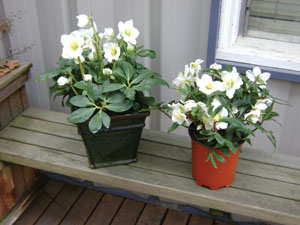2/15/2009
Helleborus for the Holidays
Greg Soles

Helleborus, commonly known as hellebore, can be propagated by division or seed. Division of the plant, however, produces identical plants and more reliable flowering.
The most important factor in producing a good retail-quality flowering hellebore is to plant liners in the finished containers early enough to take advantage of variable spring weather in which the plant thrives. If the liners are planted early on in spring, they will enjoy a strong growth curve. When the warmer summer weather arrives, hellebore growth slows down significantly. As the cool fall weather arrives, the plants enjoy another growth explosion that allows the foliage canopy to double in size. Plants flower 100% in their first year.
Technical Information
Planting: Plant liners deep, but do not bury the crown. This increases branching, which results in more flower stems. Depending on your location, you can plant outdoors when the spring night temperatures reliably stay near 30F to 35F (-1C to 2C). Plants can take a frost, but pots should not be allowed to freeze solid.
Root media: Use a media with a high coarse peat percentage.
Moisture: Plants should not be allowed to wilt; roots should be moist but not wet. Check the plant’s roots often. A healthy plant will have thick brown roots with white tips.
Fertilizer: A well-balanced fertilizer is beneficial for root development and height control. Use a fertilizer higher in nitrogen during the growing season. This will result in a higher concentration of flower shoots and larger flower diameter during forcing. Check roots often in hot weather. Plants will not be very active during very hot weather. As activity declines, decrease fertilizer application frequency or discontinue fertilizing altogether. Keep a close eye on EC levels at this time, as well, checking weekly.
Once brought inside the greenhouse for forcing, switch to a fertilizer with a higher concentration of potassium than nitrogen, such as a 0.5:1 N:K20.
lEC and pH: The fertilizer solution should be 1.0 to 1.8 mS/cm during the growing season. Once indoors, forcing cultivation requires 1.0 mS/cm. Remember to include the EC level of your clear water. Perform routine pH and EC screenings to keep levels in check. The proper pH target should be 5.5 to 6.0.
lHeat and light: Plants benefit from shade in warm climates. Growing on bare soil helps for climates with hot summers. Try to keep roots as cool as possible.
Pinching: Not required.
Pests and diseases: Thrips are common on Helleborus, and aphids enjoy them, as well. Be wary of these pests in the fall. Routine fungicide drenches are recommended for a broad spectrum of root diseases during hot weather.
Finishing: As fall temperatures decline, Helleborus will put on new growth before flowering. Hellebores enjoy cold weather and set bud easily. They can handle sub-freezing temperatures; however, if grown outdoors all winter and temperatures consistently dip below 25F (-4C), the plants should be covered or brought into a frost-free cold greenhouse.
Greg Soles is the Heuger representative for North America.